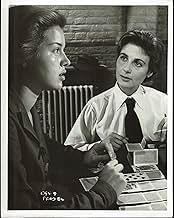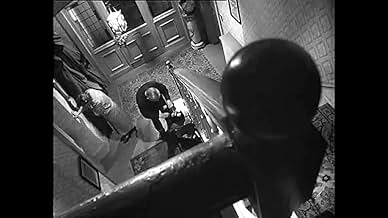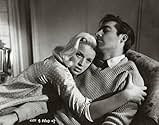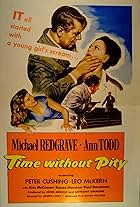IMDb RATING
7.1/10
1.6K
YOUR RATING
Locked in her cell, a murderer reflects on the events that have led her to death row.Locked in her cell, a murderer reflects on the events that have led her to death row.Locked in her cell, a murderer reflects on the events that have led her to death row.
- Nominated for 3 BAFTA Awards
- 4 nominations total
Mary Mackenzie
- Maxwell
- (as Mary MacKenzie/Mary Mackenzie)
Storyline
Did you know
- TriviaOften linked to the Ruth Ellis case, the novel and script were written two years before her trial and hanging, according to director J. Lee Thompson's biography. The resemblance was said to be coincidental.
- GoofsWhen Mary Hilton carries out the murder, she fires seven shots from a six shot revolver. There are cuts between a few different camera angles, but this all takes place as her victim slowly falls to the ground. There is no time to reload.
- ConnectionsFeatured in Empire of the Censors (1995)
Featured review
'Yield to the Night'is a child of its time, the mid fifties. Set against the grim background of the condemned cell in what is presumed to be Holloway prison (the only hanging prison for women at that time),it is a strong statement against capital punishment in general, and for a condemned woman, in particular. By 1956, popular opinion in Britain had turned against the death penalty, fuelled by a series of unpopular executions, Derek Bentley, the educationally subnormal youth hanged in 1953 for the shooting of a policeman on a Croydon factory rooftop when his seventeen year old accomplice, Chris Craig, had fired the fatal shot (Craig was too young to hang); the executions of two women in quick succession, Louisa Merrifield and Stylou Christofi, and the cause celebre of Ruth Ellis, who shot her lover, David Blakely, outside a North London public house.
Obviously Ellis was the inspiration for Dors' character, Mary Hilton (both blondes, both shoot their lovers while emotionally distraught). Director J. Lee Thompson had worked with Diana Dors in the 1954 film 'The Weak and the Wicked', which, like 'Yield to the Night', was based on a book by Joan Henry. Times had changed, even during those two intervening years, and Thompson yearned for a broader, more hard hitting statement than his earlier offering. The action scenes are much pacier, with quick scene changes and remarkable (for its day) camera angles - the shots of Dors around a fountain amount to a cinematic work of art, and the murder itself is a tour de force of close ups, almost unbearable suspense and facial expressions (note the face of the uncredited cab driver when he realises what Mary has done).
We skip the trial to the first prison scene where the governor, played to perfection by that most authoritative of actresses, Marie Ney, informs Mary that her appeal had been denied. Geoffrey Keen, as a thoughtful chaplain, leaves the cell when Mary's lawyer appears, played by the veteran Charles Lloyd Pack, with an optimism that borders on insouciance. Mary settles into the daily routine, comforted by Liam Redmond, as the caring doctor. Flashbacks trace Mary's failed romance with Jim, a once ambitious pianist whose inner emotions are in turmoil, who is reduced to playing in nightclubs and acting as a third rate host, dancing with various women, including Mary's nemesis, the well heeled Lucy. Mary is besotted with him, but he is fatally attracted to Lucy, fuelling Mary's inveterate hatred for her. Jim commits suicide, leaving a note that is addressed to Lucy, pushing Mary over the edge. The flashbacks are not as convincing as the rest of the film, but perhaps that is due to their nature - we already know that Mary has shot Lucy, so the lead up to that cataclysmic situation is somehow diluted.
However, the prison scenes more than make up for that. The set is so incredibly realistic, down to the 'door with no handle', the door through which Mary will step, on execution morning. As the clock ticks down to that fateful day, some of the finest character actresses of the day shine through the gloom - Joan Miller, whose calm exterior finally cracks when Mary's reprieve is denied, and who entwines the shell-shocked Mary's fingers around a welcome mug of tea; prolific character actress Marianne Stone, as the flustered stand in wardress; the fearsome Olga Lindo, magnificent as veteran Warder Hill, whose granite exterior finally succumbs to pity as she strokes Mary's hair, a wonderfully touching nuance of direction which would not have been possible in 'The Weak and the Wicked'. Athene Seyler, who was also in 'The Weak and the Wicked' appears as a philanthropic 'prison visitor' who gives Mary flowers from her garden. However, the performance of Yvonne Mitchell, as the caring, Christian wardress, who offers Mary a blindfold to help her sleep (much to the chagrin of Hill), is towering in its tenderness and vulnerability, even getting away with the line: 'Have you ever thought that we ALL die, some morning'? (My own mother died at 7:45 pm!) Amazingly, the line works because of the well drawn relationship between the two.
The ending is dramatic - Mary is kneeling in the chapel with the chaplain while the hangman and his assistant are watching from behind an open door - we only see their hands, the hands which will put her to death, another triumph of creative direction and camera work. On the morning of the fateful day Mary leaves her partly smoked cigarette in the ash tray and her silhouette is seen from the front, arriving through THAT door, with the chaplain behind her, a detail that was incorrect, because the assistant executioner would be behind her, having tied her hands behind her back - in 1956 the secrets of capital punishment were still closely guarded, and would not be made public until the autobiography of chief hangman Albert Pierrepoint (1977) and his one time assistant, Syd Dernley in the late eighties.
Dors showed that she really could act, and that the British film industry was capable of producing work of realism and depth, a much better film than Susan Hayward's much vaunted film about Ruth Ellis's American equivalent, Barbara Graham, 'I want to live'! And the message? A life for a life is futile, and life should be for living. Yield to this fifties gem of true excellence.
Obviously Ellis was the inspiration for Dors' character, Mary Hilton (both blondes, both shoot their lovers while emotionally distraught). Director J. Lee Thompson had worked with Diana Dors in the 1954 film 'The Weak and the Wicked', which, like 'Yield to the Night', was based on a book by Joan Henry. Times had changed, even during those two intervening years, and Thompson yearned for a broader, more hard hitting statement than his earlier offering. The action scenes are much pacier, with quick scene changes and remarkable (for its day) camera angles - the shots of Dors around a fountain amount to a cinematic work of art, and the murder itself is a tour de force of close ups, almost unbearable suspense and facial expressions (note the face of the uncredited cab driver when he realises what Mary has done).
We skip the trial to the first prison scene where the governor, played to perfection by that most authoritative of actresses, Marie Ney, informs Mary that her appeal had been denied. Geoffrey Keen, as a thoughtful chaplain, leaves the cell when Mary's lawyer appears, played by the veteran Charles Lloyd Pack, with an optimism that borders on insouciance. Mary settles into the daily routine, comforted by Liam Redmond, as the caring doctor. Flashbacks trace Mary's failed romance with Jim, a once ambitious pianist whose inner emotions are in turmoil, who is reduced to playing in nightclubs and acting as a third rate host, dancing with various women, including Mary's nemesis, the well heeled Lucy. Mary is besotted with him, but he is fatally attracted to Lucy, fuelling Mary's inveterate hatred for her. Jim commits suicide, leaving a note that is addressed to Lucy, pushing Mary over the edge. The flashbacks are not as convincing as the rest of the film, but perhaps that is due to their nature - we already know that Mary has shot Lucy, so the lead up to that cataclysmic situation is somehow diluted.
However, the prison scenes more than make up for that. The set is so incredibly realistic, down to the 'door with no handle', the door through which Mary will step, on execution morning. As the clock ticks down to that fateful day, some of the finest character actresses of the day shine through the gloom - Joan Miller, whose calm exterior finally cracks when Mary's reprieve is denied, and who entwines the shell-shocked Mary's fingers around a welcome mug of tea; prolific character actress Marianne Stone, as the flustered stand in wardress; the fearsome Olga Lindo, magnificent as veteran Warder Hill, whose granite exterior finally succumbs to pity as she strokes Mary's hair, a wonderfully touching nuance of direction which would not have been possible in 'The Weak and the Wicked'. Athene Seyler, who was also in 'The Weak and the Wicked' appears as a philanthropic 'prison visitor' who gives Mary flowers from her garden. However, the performance of Yvonne Mitchell, as the caring, Christian wardress, who offers Mary a blindfold to help her sleep (much to the chagrin of Hill), is towering in its tenderness and vulnerability, even getting away with the line: 'Have you ever thought that we ALL die, some morning'? (My own mother died at 7:45 pm!) Amazingly, the line works because of the well drawn relationship between the two.
The ending is dramatic - Mary is kneeling in the chapel with the chaplain while the hangman and his assistant are watching from behind an open door - we only see their hands, the hands which will put her to death, another triumph of creative direction and camera work. On the morning of the fateful day Mary leaves her partly smoked cigarette in the ash tray and her silhouette is seen from the front, arriving through THAT door, with the chaplain behind her, a detail that was incorrect, because the assistant executioner would be behind her, having tied her hands behind her back - in 1956 the secrets of capital punishment were still closely guarded, and would not be made public until the autobiography of chief hangman Albert Pierrepoint (1977) and his one time assistant, Syd Dernley in the late eighties.
Dors showed that she really could act, and that the British film industry was capable of producing work of realism and depth, a much better film than Susan Hayward's much vaunted film about Ruth Ellis's American equivalent, Barbara Graham, 'I want to live'! And the message? A life for a life is futile, and life should be for living. Yield to this fifties gem of true excellence.
- music-room
- Dec 12, 2006
- Permalink
- How long is Yield to the Night?Powered by Alexa
Details
- Release date
- Country of origin
- Language
- Also known as
- Umfange mich, Nacht
- Filming locations
- Italian Gardens, Hyde Park, London, England, UK(romantic scene between the lovers/later scene with Dors reading newspaper)
- Production companies
- See more company credits at IMDbPro
- Runtime1 hour 39 minutes
- Color
- Aspect ratio
- 1.37 : 1
Contribute to this page
Suggest an edit or add missing content
































